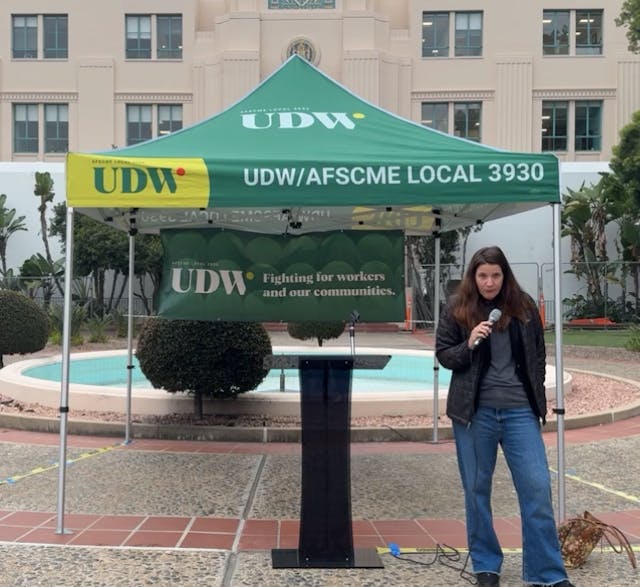My Life in Juarez: Women Speak Out
Frontera NorteSur
Growing up in Ciudad Juarez, Rosa Ines Minjares did not think the episodes of violence against women that she saw flashed all over the television screen would personally affect her. All that changed one day in 2009 when her close friend, Maria Guadalupe Guardado, was murdered. The 16-year had been tortured, raped, shot twice and then dumped in an empty lot, according to Minjares.
“My life changed when my friend was murdered. Her murder remains unpunished like many of the other cases,” Minjares told an audience at an Autonomous University of Ciudad Juarez (UACJ) gathering held to commemorate March 8, International Women’s Day.
“I live with the fear that there are many murderers on the streets,” Minjares said.
At 19, Minjares has internalized, analyzed and expressed the grand paradox of Juarez: On the one hand, the Mexican border city is a dynamic place that represents the lure of opportunity and a chance for economic advancement. On the other, it is a place where residents are burdened with the effects of the drug trade, organized crime and gender violence, the young Juarense said.
“I feel sad and insecure, but I intend to overcome this,” Minjares said. “I love my city and my roots, and that’s why I live with hope.”
In Minjares’ worldview, Lupe Guardado was one person who did not live to see the great hope of Juarez come to fruition. Raised by grandparents, Guardado dreamed of becoming a teacher, Minjares told FNS.
Minjares’ story was among several featured at a UACJ panel of new women writers whose works will appear in the forthcoming, third edition of My Life in Juarez: Voices of Women, a periodic book that showcases non-professional writers from different walks of life.
Since 2006, 180 women have participated in workshops designed to encourage and publish women’s voices, said Veronica Corchado, spokesperson for the Art, Community and Equity Collective, a local civil society group which helps organize the literary production. “The objective is to link the community with academia,” Corchado said of one of the project’s goals.
Previous editions of My Life in Juarez are out of print, the cultural activist added, after about 2,000 copies of each run were given away free.
Featuring stories from Min-jares and other new writers, the 2014 edition will be published with support from the Ford and Angelica foundations, according to Corchado.
The new stories speak about violence and discrimination, but are also graced with tales of resistance, sheer survival and a determination to beat the odds.
Sharing the stage with Minjares and other fellow writers, 13-year-old Jennifer Paola Javier fought back tears as she recalled bullying and marginali-zation because of a facial tumor that left her physically scarred.
Befriending a girl who suffered cancer, Javier said the pair was treated like “dirty rats” by taunting peers. The teen credited a psychologist’s help, along with a profile of her plight in a local newspaper, for building self-esteem.
“I feel good about myself,” Javier said. “I have a mark on my face. The important thing is to be a good person.”
Hailing from a different generation than either Minjares or Javier, Rosa Maria Sanchez recounted how she rose from poverty to pursue a professional career that had long been very difficult for a woman from her background to attain. Now a social worker, Sanchez told how her family had moved to the borderland from the state of Durango when she was only two years old.
To survive, family members worked as domestic helpers, labored as factory workers and sold homemade bread. Different work and school schedules made a collective family meal nearly impossible, Sanchez recalled. The struggling woman supported herself by becoming a hair stylist, but never abandoned her dream of attending the university, a goal she achieved much later in life than the “traditional” student.
“At 53 years of age the most gratifying thing is that the students call me teacher,” Sanchez concluded.
The UACJ writers’ panel and award ceremony culminated a week-long series of activities staged by community members in cooperation with the UACJ’s Social Sciences Institute, Humanities Department and the Graduate Program of Interdisciplinary Gender Studies.
The My Life In Juarez writing project, said organizer Veronica Corchado, provides a very personal outlet for women to articulate their deepest feelings and experiences. The issue of violence was a common thread in this year’s submissions, she said.
“It seemed that the women don’t have a way of addressing violence, and it’s done through writing. It’s a way of telling stories that can’t be told otherwise, another channel for words, different than the media, non-governmental organizations…”
Not all the women who participate in the writers’ workshops, where they exposed to the techniques of the craft, are interested in getting published. “Some say I want to write just for me, and that’s super valid,” Corchado added.
In Ciudad Juarez, women poets and rappers round out the rich ranks of writers.
An acupuncturist in her day job, Dr. Armine Arjona is also a poet, novelist and short story writer. In an interview, Arjona admitted she delves into “heavy subjects” whose characters include pedophile priests, killers and narco-traffickers. But the writer lightens her text with doses of eroticism and humor.
Handed an award for her literary contributions by the UACJ, Arjona evoked laughter from a crowd in her reading of “La Cosecha,” a story about poor campesinos from the Chihuahua mountains who attempt to make a fast buck by cultivating marijuana but wind up losing their crop to the chomping jowls of “vice-ridden cows.”
Like Rosa Minjares, Arjona has been personally touched by violence. She described the late poet Susana Chavez, murdered in January 2011, as a good friend with a bent for trusting people.
Chavez was known for her poems about the women’s murders that first gained international attention back in the 1990s. Arjona criticized the early release of one of the three young men arrested for Cha-vez’s killing as another example of the impunity that still haunts Juarez.
Springing from the hip hop culture, Batallones Femeninos (Femenine Battalions) consists of 11 young women, 8 from Juarez and 3 from other Mexican cities. In between family and work responsibilities, the national group records rap songs via the digital cloud and delivers public performances at varied venues, including on the loud, rickety buses that clamber along Juarez’s pot hole-laden streets.
“(Bus riders) get surprised, because rap is usually identified with men,” said Batallones Femininos co-founder Susana Molina. “But after hearing us, they thank us because the words are realistic. We’ve had an impact on older people because of the content.”
Similar to Arjona’s prose, Batallones Femininos’ words are raw, unnerving, bold and imaginative.
“Rap is what you live,” Molina mused. “(Our) lives in Juarez are marked by femicide, violence and youth poverty.”
A brief but rousing performance by Molina and two other Batallones Femininos members was the grand finale of the week at the UACJ dedicated to women.
Scenes from the streets of Juarez on the weekend of International Women’s Day 2014 evidenced that the issues verbalized by the women rappers and writers were far from resolved.
For the umpteenth time, mothers and supporters of scores of disappeared girls and women staged a protest at the regional office of the Chihuahua state prosecutor, demanding results from investigations.
In the downtown zone, where many of the women were last seen alive, the ink on old posters of the missing faded into the aging buildings almost like historical life-blood seeping into the city’s soul.
The long anticipated, expansive plaza on Avenida 16 de Septiembre, constructed to revive the commercial corridor as a pedestrian-friendly space, is now blocked off to cars and open to foot traffic. On one side of the new plaza, where another construction project is still underway, big pink and black crosses, the symbols of the fight against femicide, have been painted by an artist or artists on the concrete barriers.






